If you aren’t yet using Microsoft OneDrive, you may not be aware of the live collaboration capabilities available. Office 365 and OneDrive allow people in different locations to collaborate on the same file simultaneously. They can view and track each other’s edits in real-time.
My hope is that you’re already taking advantage of this capability. There are a few other benefits to live collaboration, and OneDrive in general, that you may not know about before you start collaborating:
-
Automatic Version Control
Under the hood, OneDrive is really SharePoint, and it automatically tracks versions. By default, up to 500 minor versions of a file can be archived. This means that if you screw a file up you can easily roll back to a previous version. -
Automatic Saving
Ever lose your progress on a file? That no longer happens with automatic saving. The trick to this is you need to save the file once – I recommend doing this when you create the file. After that you can edit away happily and trust that your changes are being saved and tracked. -
Email Links instead of Attachments
Stop emailing attachments. Seriously. They balloon the size of your inbox/outbox and an attachment can be sent to the wrong person by accident. If your files are in OneDrive, you can click the ‘Share’ button in the top right corner of any office application (Word, Excel, PowerPoint, etc) and send a link those who need to collaborate
These features are very nice. They improve your employee experience and increase security at the same time. But one feature I don’t see leveraged very often is the ability to share externally with outside guests.
Sharing with External Users
Live collaboration, automatic backup, automatic saving, and link and file sharing are all great features. With OneDrive, these features work not only within your organization but also with external guests.
For users, there is a quick and easy way to set up an external share using a sharing link.
First, create a new folder in OneDrive. I recommend calling it ‘External Share’ in the sharing settings or something that is obvious and easy to find again.
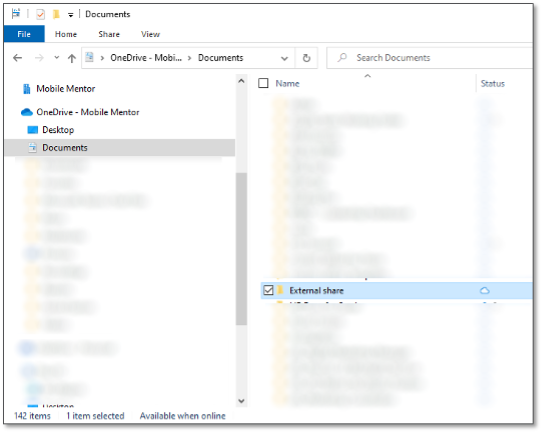
Next, open that folder then create individual folders to any person (or group) you want to share to. Name those folders as you see fit.

Next, wait for the folder to sync. This usually takes ~10 seconds or so and the status icon will change to a cloud icon once complete.
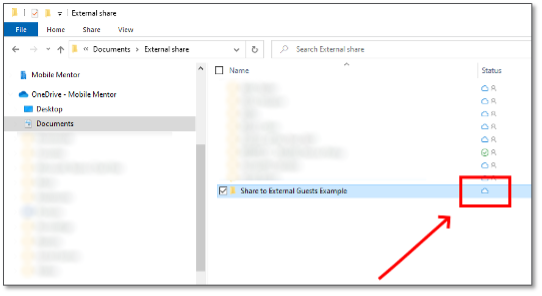
Now right-click the folder and choose Share.
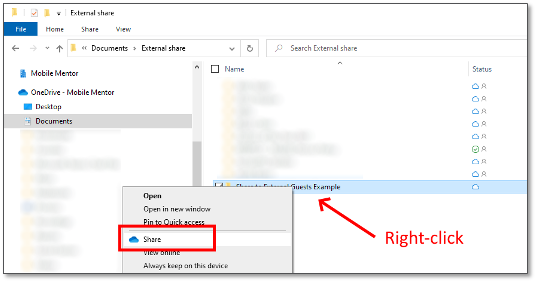
In the pop-up window, click on the button that says, People in [Your Organization] with the link can edit > and change it to Anyone with the link. Then optionally set a password – I recommend this step as it adds some security around the external link in case your guest accidently emails the link to someone unintended.

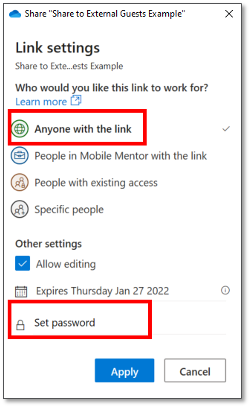
Finally, click Apply then click Copy link. Now you can email that link to your intended external user, and they can edit any file contained within that folder for 30 days (or fewer if you set it to a more limited timeframe).
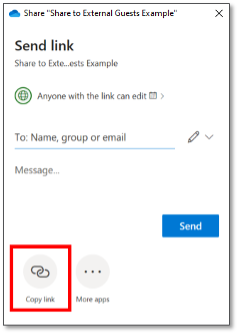
That’s it. Using this you can now invite external guests to work on files using live collaboration and automatic version control. By using a designated ‘External Share’ folder and placing all shares inside of it, you can easily manage your own external sharing as well.
IT Administrators, Governance, and Azure AD Configuration
For IT Administrators, there are some options available to formalize external access and manage access. These require some thought and governance. Ideally, IT should formalize a guest access policy and external sharing settings and then institute SOPs for establishing (and properly controlling) guest access.
At a minimum, you should establish regular access reviews and designate approvers.
You can govern external users through Azure AD entitlement management. If you are interested you can read about how it works and how to enable it by going here: https://docs.microsoft.com/en-us/azure/active-directory/governance/entitlement-management-external-users
Further, you can set up direct access to Microsoft Teams using either Guest access or full federation. This will include the live collaboration capabilities of OneDrive.
Conclusion
Are you taking advantage of all the modern capabilities of Microsoft 365? There are a ton of new capabilities that can improve your employee experience and increase security. If you are curious about leveraging all the potentials, consider our Modern Work Accelerator. It’s a short consulting session to help you find strengths and weaknesses in your IT. You’ll get advice on how to improve and achieve quick success.
Contact us to learn more!





